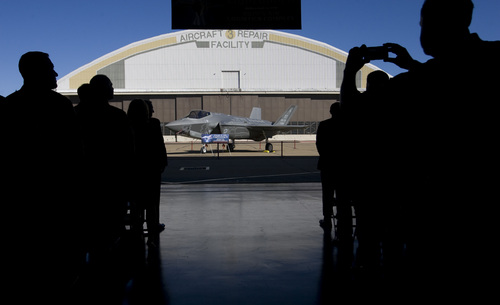This is an archived article that was published on sltrib.com in 2014, and information in the article may be outdated. It is provided only for personal research purposes and may not be reprinted.
A squadron of the U.S. military's new fighter jet is landing at Hill Air Force Base next year, but a government report says software problems could prevent the F-35 from flying into combat on schedule.
The report from the Government Accountability Office says the F-35 may need an extra 13 months to be ready. It's not the engines or the wings or anything mechanical that's causing delays, but the millions of lines of computer code that help make the F-35 the most sophisticated fighter jet U.S. pilots have ever flown.
"Challenges in development and testing of mission systems software continued through 2013," the GAO report said, "due largely to delays in software delivery, limited capability in the software when delivered, and the need to fix problems and retest multiple software versions."
In all, the F-35 program fell 11 percent short of its planned testing in 2013.
In response to the report, Air Force Lt. Gen. Chris Bogdan, the F-35 Program Executive Officer, issued a statement saying the Department of Defense concurred with the GAO report. However, Bogdan contradicted the idea that more delays may result.
"Software continues to remain our number one technical risk on the program and we have instituted disciplined systems engineering processes to address the complexity of writing, testing and integrating software," Bogdan said. "We are confident about delivering the F-35's initial warfighting capability to the U.S. Marine Corps in 2015 and to the U.S. Air Force in 2016."
Hill Air Force Base was not mentioned in the report, which was published Monday. The base's 388th Fighter Wing is to receive a squadron of 72 of the jets next year. The Air Force has said its F-35s will be ready for warfare in 2016. Hill Air Force Base has already started conducting maintenance on F-35s.
There are F-35 versions for the Air Force, Navy and Marine Corps. The GAO report indicates the software problems are most acute for the Marine Corps version because it planned to have F-35s ready to fight in 2015. But the Air Force planned to use the same software — with some upgrades — to fly combat-ready F-35s in 2016. The Navy planned for its F-35s to be ready in 2018.
The delays are going to add to the cost, the GAO said. The Department of Defense will have to increase funding to an average of $12.6 billion per year through 2037, the report said. The F-35 is already to be the first trillion dollar weapons program. Every dollar more spent in production, testing or maintenance could deter the Pentagon or Congress from buying additional F-35s.
There was some good news. In 2013, the GAO said, the F-35 manufacturing process became more efficient and improvements were made in delivering supplies necessary for the jet.
Also, the F-35 program improved some technical aspects of the jet, including fixes to the helmet display that delivers camera views and other information to the pilot, the GAO said.
Twitter: @natecarlisle





